| Listing 1 - 10 of 11 | << page >> |
Sort by
|

ISBN: 0691094209 Year: 1986 Publisher: Princeton University Press
Abstract | Keywords | Export | Availability | Bookmark
 Loading...
Loading...Choose an application
- Reference Manager
- EndNote
- RefWorks (Direct export to RefWorks)
Tracing devotion to Mary to psychological and historical processes that began in the fifth century, Michael Carroll answers intriguing questions: What explains the many reports of Marian apparitions over the centuries? Why is Mary both "Virgin" and "Mother" simultaneously? Why has the Marian cult always been stronger in certain geographical areas than in others? The first half of the book presents a psychoanalytic explanation for the most salient facts about the Marian cult and the second addresses the question of Marian apparitions.
232.931.8 --- #GMML:Maria --- Mariacultus. Mariadevotie--(theologische fundering) --- Mary Blessed Virgin, Saint --- -Mary Blessed Virgin, Saint --- -Apparitions and miracles --- Devotion to --- Mary, --- Devotion to. --- Apparitions and miracles. --- 232.931.8 Mariacultus. Mariadevotie--(theologische fundering) --- ʻAdhrāʼ --- Arogyamata --- Ārōkkiyamāta --- Birhen ng mga Dukha --- Blessed Lady --- Blessed Mother --- Blessed Virgin Mary, --- Hagnē Theotokos --- Madonna, The --- Mama Mary --- Mare de Déu --- Maria, --- Mariam Astuatsatsin --- Marie, --- Marie Théotokos --- Marii︠a︡, --- Maryam, --- Maryja, --- Meryem Ana --- Miryam, --- Mother of God --- Muíre, --- Nossa Senhora --- Our Lady --- Our Lady of Good Health --- Our Lady of Sorrows --- Our Lady of the Blessed Sacrament --- Qiddīsah Maryam --- Theotokos --- Vierge Marie, --- Virgen María --- Virgin Mary, --- Virgin of the Poor --- Ynang Maria --- مريم --- مريم العذراء --- 성모마리아 --- Our Lady of Emmitsburg --- Majka Isusova --- Mary [Blessed Virgin ] --- Cult --- Mariam Astuatsatsin, --- Meryem Ana, --- Virgen María, --- Ynang Maria,
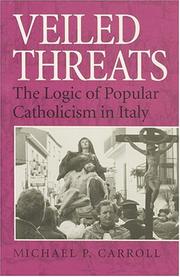
ISBN: 0801852900 Year: 1996 Publisher: Baltimore ; London Johns Hopkins University Press
Abstract | Keywords | Export | Availability | Bookmark
 Loading...
Loading...Choose an application
- Reference Manager
- EndNote
- RefWorks (Direct export to RefWorks)
Catholics --- Catholiques --- Italy --- Italie --- Religious life and customs. --- Vie religieuse --- 269*2 --- 398.3 --- -Christians --- Volksreligie. Volksgodsdienstigheid --- Volksgeloof. Volksgebruiken. Kalenderfeesten --- -Volksreligie. Volksgodsdienstigheid --- 398.3 Volksgeloof. Volksgebruiken. Kalenderfeesten --- 269*2 Volksreligie. Volksgodsdienstigheid --- -398.3 Volksgeloof. Volksgebruiken. Kalenderfeesten --- Religious life --- Religious life and customs
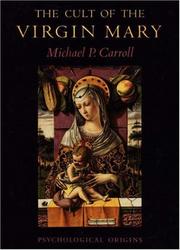
ISBN: 0691028672 0691094209 0691222975 Year: 1992 Publisher: Princeton, N.J. : Princeton University Press,
Abstract | Keywords | Export | Availability | Bookmark
 Loading...
Loading...Choose an application
- Reference Manager
- EndNote
- RefWorks (Direct export to RefWorks)
Tracing devotion to Mary to psychological and historical processes that began in the fifth century, Michael Carroll answers intriguing questions: What explains the many reports of Marian apparitions over the centuries? Why is Mary both "Virgin" and "Mother" simultaneously? Why has the Marian cult always been stronger in certain geographical areas than in others? The first half of the book presents a psychoanalytic explanation for the most salient facts about the Marian cult and the second addresses the question of Marian apparitions.
Mary, --- Marie, --- Apparitions and miracles --- Cult --- Apparitions et miracles --- Culte --- #GBIB:SMM --- Apparitions and miracles. --- Cult. --- RELIGION / History. --- Devotion to. --- Agdistus. --- Albigensians. --- Anglicanism. --- Annunciation. --- Anubis. --- Aquero. --- Arnobius. --- Asheroth. --- Beauraing. --- Catherine of Raconigi. --- Children of Mary. --- Collyridians. --- Communism. --- Cova da Iria. --- Decius Mundus. --- Demeter. --- Diana. --- Edict of Nantes. --- Epiphanius. --- Eusebius. --- Gaia. --- Hannibal. --- Holy Family. --- Hussites. --- Jesus Christ. --- Josephus. --- Jupiter. --- Latapie, Elise. --- Lollards. --- Lutherans. --- Magnificat. --- Marian Congresses. --- Marian Year. --- Muslims. --- Napoleon. --- Orthodox Churches. --- Ovid. --- Panarion. --- The Golden Bough. --- alimentary institution. --- castration anxiety. --- castration. --- celibacy. --- dies sanquinis. --- dreamwork. --- ecumenism. --- fertility goddesses. --- folklore. --- hypostatic union. --- identification. --- imitation. --- matriarchies. --- matrilocal residence. --- mysterious lights. --- octave, defined. --- paleolithic religion.
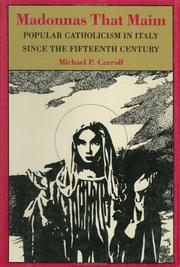
ISBN: 0801842999 9780801842993 Year: 1992 Publisher: Baltimore: Johns Hopkins University press,
Abstract | Keywords | Export | Availability | Bookmark
 Loading...
Loading...Choose an application
- Reference Manager
- EndNote
- RefWorks (Direct export to RefWorks)
Mary, --- Cult --- Catholic Church --- History --- Italy --- Italie --- Religious life and customs. --- Vie religieuse --- Catholics --- Religion. --- 269*2 --- 248.159.4 <45> --- -Christians --- Volksreligie. Volksgodsdienstigheid --- Mariale devotie. Verering van O. L. Vrouw. Mariamaand--Italië --- Religion --- -Volksreligie. Volksgodsdienstigheid --- 248.159.4 <45> Mariale devotie. Verering van O. L. Vrouw. Mariamaand--Italië --- 269*2 Volksreligie. Volksgodsdienstigheid --- -269*2 Volksreligie. Volksgodsdienstigheid --- Christians --- History. --- Cult. --- Catholics - Italy - Religion. --- Italy - Religious life and customs.
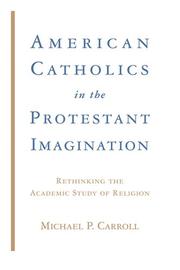
ISBN: 9780801886836 080188683X 1421401991 Year: 2007 Publisher: Baltimore : Johns Hopkins University Press,
Abstract | Keywords | Export | Availability | Bookmark
 Loading...
Loading...Choose an application
- Reference Manager
- EndNote
- RefWorks (Direct export to RefWorks)
Michael P. Carroll argues that the academic study of religion in the United States continues to be shaped by a "Protestant imagination" that has warped our perception of the American religious experience and its written history and analysis.In this provocative study, Carroll explores a number of historiographical puzzles that emerge from the American Catholic story as it has been understood through the Protestant tradition. Reexamining the experience of Catholicism among Irish immigrants, Italian Americans, Acadians and Cajuns, and Hispanics, Carroll debunks the myths that have informed much of this history.Shedding new light on lived religion in America, Carroll moves an entire academic field in new, exciting directions and challenges his fellow scholars to open their minds and eyes to develop fresh interpretations of American religious history.
Catholics --- -Catholics --- -282 <73> --- 27 <73> --- Christians --- History. --- Historiography. --- Katholieke Kerk. Rooms-katholieken--Verenigde Staten van Amerika. VSA. USA --- Kerkgeschiedenis--Verenigde Staten van Amerika. VSA. USA --- Historiography --- History --- 282 <73>
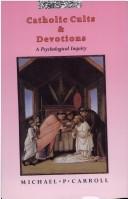
ISBN: 0773506934 Year: 1989 Publisher: Kingston McGill-Queen's University Press
Abstract | Keywords | Export | Availability | Bookmark
 Loading...
Loading...Choose an application
- Reference Manager
- EndNote
- RefWorks (Direct export to RefWorks)
Catholic Church --- Customs and practices --- Psychological aspects. --- Controversial literature. --- Christian special devotions --- Depth psychology --- Dieptepsychologie --- Christelijke bijzondere devoties

ISBN: 1282851292 9786612851292 0773561951 9780773561953 0773506934 9780773506930 9781282851290 Year: 1989 Publisher: Kingston McGill-Queen's University Press
Abstract | Keywords | Export | Availability | Bookmark
 Loading...
Loading...Choose an application
- Reference Manager
- EndNote
- RefWorks (Direct export to RefWorks)
Michael Carroll is the first to bring psychoanalytic theory to bear on a range of Catholic cults and devotions, including the Rosary, the Angelus, the Stations of the Cross, the Blood Miracles of Naples, the Stigmata, the Forty Hours, the Brown Scapular, and the Sacred Heart of Jesus. Carroll assembles a great deal of historical information that until now has been widely scattered in obscure publications. He suggests why such devotions are absent from the Protestant tradition and argues for a new and more subtle appreciation of the role that Italian Catholicism played in shaping Catholicism generally.
Cults. --- Alternative religious movements --- Cult --- Cultus --- Marginal religious movements --- New religions --- New religious movements --- NRMs (Religion) --- Religious movements, Alternative --- Religious movements, Marginal --- Religious movements, New --- Religions --- Sects --- Catholic Church --- Customs and practices --- Psychological aspects. --- Church of Rome --- Roman Catholic Church --- Katholische Kirche --- Katolyt︠s︡ʹka t︠s︡erkva --- Römisch-Katholische Kirche --- Römische Kirche --- Ecclesia Catholica --- Eglise catholique --- Eglise catholique-romaine --- Katolicheskai︠a︡ t︠s︡erkovʹ --- Chiesa cattolica --- Iglesia Católica --- Kościół Katolicki --- Katolicki Kościół --- Kościół Rzymskokatolicki --- Nihon Katorikku Kyōkai --- Katholikē Ekklēsia --- Gereja Katolik --- Kenesiyah ha-Ḳatolit --- Kanisa Katoliki --- כנסיה הקתולית --- כנסייה הקתולית --- 가톨릭교 --- 천주교 --- Cults
Book
ISBN: 1421428318 Year: 2007 Publisher: Johns Hopkins University Press
Abstract | Keywords | Export | Availability | Bookmark
 Loading...
Loading...Choose an application
- Reference Manager
- EndNote
- RefWorks (Direct export to RefWorks)
Michael P. Carroll argues that the academic study of religion in the United States continues to be shaped by a "Protestant imagination" that has warped our perception of the American religious experience and its written history and analysis.In this provocative study, Carroll explores a number of historiographical puzzles that emerge from the American Catholic story as it has been understood through the Protestant tradition. Reexamining the experience of Catholicism among Irish immigrants, Italian Americans, Acadians and Cajuns, and Hispanics, Carroll debunks the myths that have informed much of this history.Shedding new light on lived religion in America, Carroll moves an entire academic field in new, exciting directions and challenges his fellow scholars to open their minds and eyes to develop fresh interpretations of American religious history.

ISBN: 0801870550 9780801870552 Year: 2002 Publisher: Baltimore: Johns Hopkins University press,
Abstract | Keywords | Export | Availability | Bookmark
 Loading...
Loading...Choose an application
- Reference Manager
- EndNote
- RefWorks (Direct export to RefWorks)
The Penitente brotherhood of New Mexico soared in popularity during the early nineteenth century. Local chapters of the brotherhood, always exclusively male, met in specially constructed buildings (called moradas) to conduct their business and engaged in a variety of religious rituals, including flagellation. The traditional view, still very much accepted, is that Penitente spirituality was a continuation of pietistic practices brought to the New World from Spain by Franciscan missionaries in the sixteenth century. In this book sociologist of religion Michael Carroll argues that the movement in factdeveloped much later. There is in fact little evidence that Hispanos in pre-1770 New Mexico were particularly religious, and indeed the usual hallmarks of popular Catholicism -- such as apparitions, cults organized around miraculous images, or pilgrimage--are noticeable by their absence. Carroll traces the rise of the Penitentes to social changes, including the Bourbon reforms, that undermined patriarchal authority and thereby threatened a system that was central to the social organization of late colonial New Mexico. Once established, the Penitentes came to incorporate a number of organizational elements not found in traditional confraternities. As a result, Carroll concludes, Penitente membership facilitated the "rise of the modern" in New Mexico and--however unintentionally--made it that much easier, after the territory's annexation by the United States, for the Anglo legal system to dispossess Hispanos of their land.
Patriarchy --- Religious aspects --- Catholic Church. --- Hermanos Penitentes.
Book
ISBN: 9780691222974 Year: 2021 Publisher: Princeton, NJ
Abstract | Keywords | Export | Availability | Bookmark
 Loading...
Loading...Choose an application
- Reference Manager
- EndNote
- RefWorks (Direct export to RefWorks)
| Listing 1 - 10 of 11 | << page >> |
Sort by
|

 Search
Search Feedback
Feedback About UniCat
About UniCat  Help
Help News
News